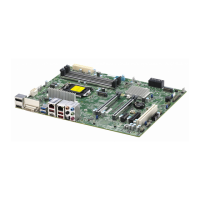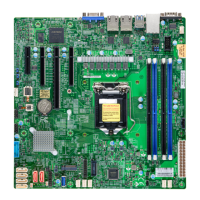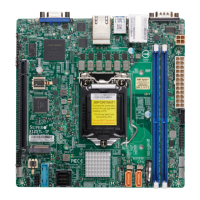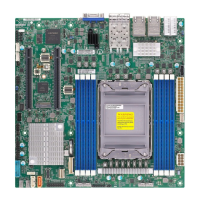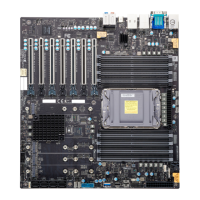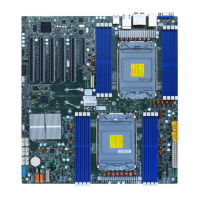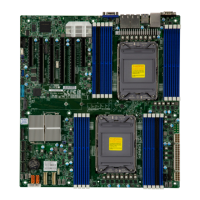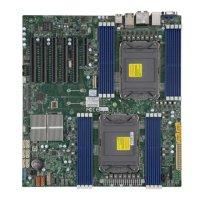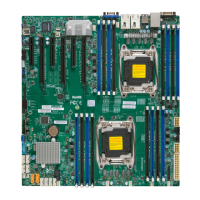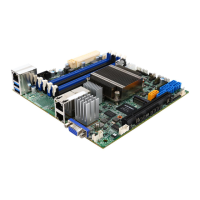Do you have a question about the Supermicro X12SAE and is the answer not in the manual?
Manual's purpose, audience, and scope.
Key features and specifications of the X12SAE/X12SCA-F motherboard.
Explains symbols and their meanings for proper installation and safety.
Lists motherboard components and provides essential web links.
Visual layout of motherboard components for X12SAE/X12SCA-F.
Table summarizing jumper and LED definitions and default settings.
Details about the supported processor and Intel PCH W480 chipset.
Describes special features like recovery from AC power loss.
Explains onboard voltage, temperature, and fan monitoring.
Details about Advanced Configuration and Power Interface features.
Specifies power supply requirements for the motherboard.
Describes serial ports and Super I/O controller capabilities.
Details about the supported CPU.
Information on memory support and specifications.
Specifies the Intel PCH W480 chipset.
Lists the available PCI and M.2 expansion slots.
Details the network controllers on the motherboard.
Lists serial, SATA, and video output ports.
Describes front and rear USB port configurations.
Lists BIOS features like AMI BIOS, ACPI, Plug and Play.
Details ACPI power management features.
Explains onboard voltage and temperature monitoring.
Describes fan control features and headers.
Covers TPM and SuperDoctor 5.
Lists and describes onboard LED indicators.
Specifies the motherboard's physical dimensions.
Measures to protect components from ESD and unpacking instructions.
Step-by-step guides for CPU and heatsink installation.
Tools, mounting holes, and steps for installing the motherboard.
Guidelines for memory performance and DIMM installation/removal.
Instructions for installing M.2 SSDs.
Detailed description of all rear I/O ports and connectors.
Explains front panel headers, LEDs, and buttons.
Pinout for power connectors and various onboard headers.
How jumpers work and specific settings for LAN, CMOS, Watch Dog, etc.
Explains LAN, IPMI, Power, and error LEDs.
Steps to diagnose and resolve system issues like no power, video, or boot failure.
Steps to take before contacting Supermicro for technical assistance.
Answers to common user questions about memory and BIOS.
Procedures for battery removal, installation, and proper disposal.
Procedure for returning products for warranty service.
Overview of UEFI BIOS, main screen, and date/time settings.
Accessing and understanding the advanced BIOS settings menu.
Configuration for power management, ACPI, boot behavior, and system power states.
Detailed settings for CPU features, cores, caches, and memory modules.
Settings for graphics controller, memory allocation, and DMI.
Settings for IO, PCIe, ASPM, and Super IO ports.
Configuration for COM ports, SOL, AMT, EMS, and console redirection.
Settings for USB ports, iSCSI initiator, and Ethernet connection.
Managing event logs and monitoring system health and temperatures.
Configuring Intelligent Platform Management Interface settings.
Configuring administrator/user passwords, secure boot, and device security.
Configuring boot mode, device order, and boot options.
Options for saving changes, loading defaults, and exiting the BIOS setup.
Lists beep codes indicating POST errors and their meanings.
Information on additional checkpoint codes for POST diagnostics.
Steps for installing Windows OS, including RAID drivers.
Guide to downloading and installing system drivers from Supermicro.
Overview of SuperDoctor 5 for system monitoring and management.
Information on IPMI support and logging into the BMC.
Warnings regarding battery replacement and disposal across multiple languages.
Guidelines for proper product disposal according to regulations.
Explains the UEFI firmware interface and its boot process.
Step-by-step guide for BIOS recovery using a USB device.
| Audio chip | RealTek ALC888S |
|---|---|
| Component for | PC |
| Motherboard chipset | Intel W480 |
| Audio output channels | - channels |
| Motherboard form factor | ATX |
| Motherboard chipset family | Intel |
| Processor socket | LGA 1200 (Socket H5) |
| Compatible processor series | Intel Celeron E, Intel Core i3, Intel Core i5, Intel Core i7, Intel Core i9, Intel Pentium, Intel Xeon |
| ECC | Yes |
| Memory voltage | 1.2 V |
| Memory slots type | DIMM |
| Number of memory slots | 4 |
| Supported memory types | DDR4-SDRAM |
| Maximum internal memory | 128 GB |
| Supported memory clock speeds | 2933 MHz |
| Supported memory module capacities | 2GB, 4GB, 8GB, 16GB, 32GB |
| Wi-Fi | - |
| LAN controller | Intel I219-LM, Intel I225-V |
| RAID levels | 0, 1, 5, 10 |
| Supported storage drive interfaces | SATA III |
| BIOS type | AMI |
| ACPI version | 6.0 |
| BIOS memory size | 256 Mbit |
| System Management BIOS (SMBIOS) version | 3.0 |
| Operating temperature (T-T) | 0 - 50 °C |
| PCI Express x1 (Gen 3.x) slots | 1 |
| PCI Express x16 (Gen 3.x) slots | 2 |
| USB 2.0 ports quantity | 0 |
| USB 3.2 Gen 2 (3.1 Gen 2) Type-A ports quantity | 3 |
| Harmonized System (HS) code | 84733020 |
| Depth | 243.8 mm |
|---|---|
| Width | 304.8 mm |
